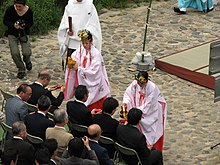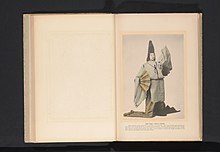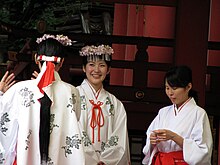Miko

| Part ofa serieson |
| Shinto |
|---|
 |
Amiko(Vu nữ),orshrine maiden,[1][2]is a youngpriestess[3]who works at aShinto shrine.Mikowere once likely seen asshamans,[4]but are understood in modern Japanese culture to be an institutionalized[5]role in daily life, trained to perform tasks, ranging fromsacredcleansing[4]to performing the sacredKaguradance.[6]
Appearance
[edit]Thetraditional attireof amikois a pair of redhakama(Phi khố)(divided, pleated trousers), a whitekosode(a predecessor of thekimono), and some white or red hair ribbons. InShinto,the color white symbolizes purity.[citation needed]The garment put over thekosodeduringKaguradances is called achihaya(Thiên tảo).
Traditionalmikotools include theAzusa Yumi(Tử cung,"catalpa bow" ),[7]thetamagushi(Ngọc xuyến)(offertorysakaki-tree branches),[8]and thegehōbako(Ngoại pháp tương,a "supernatural box that contains dolls, animal and human skulls... [and] Shinto prayer beads" ).[9]
Mikoalso use bells, drums, candles,gohei,and bowls of rice in ceremonies.
Definition
[edit]


The Japanese wordsmikoandfujo( "female shaman" and "shrine maiden" respectively)[10]are usually writtenVu nữ[10]as a compound of the kanjiVu( "shaman" ), andNữ( "woman" ).[10]Mikowas archaically writtenThần tử( "kami"+" child ")[10]andVu tử( "shaman child" ).[10]
The term is not to be confused withmikomeaning "prince", "princess" or "duke", and which is otherwise variously speltNgự tử( "august child" ),Hoàng tử( "imperial child" ),Hoàng nữ( "imperial daughter", also pronouncedhimemiko),Thân vương( "prince" ) orVương( "king", "prince" or "duke" ). These spellings ofmikowere commonly used in the titles of ancient Japanese nobles, such asPrince Kusakabe(Thảo bích hoàng tử,Kusakabe no MikoorKusakabe no Ōji).
Mikoonce performed spirit possession andtakusen(whereby the possessed person serves as a "medium" (yorimashi) to communicate the divine will or message of thatkamior spirit; also included in the category oftakusenis "dream revelation" (mukoku), in which akamiappears in a dream to communicate its will)[11]as vocational functions in their service to shrines. As time passed, they left the shrines and began working independently in secular society. In addition to a medium or amiko(or ageki,a male shaman), the site of atakusenmay occasionally also be attended by asayaniwa[12]who interprets the words of the possessed person to make them comprehensible to other people present.Kamigakariandtakusen[11]may be passive, when a person speaks after suddenly becoming involuntarily possessed or has a dream revelation; they can also be active, when spirit possession is induced in a specific person to ascertain the divine will or gain a divine revelation.[11]
Mikoare known by many names; Fairchild lists 26 terms for "shrine-attachedMiko"[13]and 43 for "non-shrine-attachedMiko".[14]Other names areichiko(Vu tử,"shaman child" ),or "market/town child"(Vu tử)(both likelyatejimeaning "female medium; fortuneteller" ),[10]andreibai(Linh môi,meaning "spirit go-between, medium" ).[10]
In English, the word is often translated as "shrine maiden", though freer renderings often simply use the phrase "female shaman" (shamanka)[citation needed]or, asLafcadio Hearntranslated it, "Divineress".[15]Some scholars[citation needed]prefer the transliterationmiko,contrasting the JapaneseMikoism[citation needed]with other Asian terms for female shamans.[citation needed]As Fairchild explains:
Women played an important role in a region stretching from Manchuria, China, Korea and Japan to the [Ryukyu Islands]. In Japan these women were priestesses, soothsayers, magicians, prophets and shamans in the folk religion, and they were the chief performers in organized Shinto. These women were called Miko, and the author calls the complex "Mikoism" for lack of a suitable English word.[16]
The word can also mean "shrine virgin".[17]
Mikoism
[edit]History
[edit]
Mikotraditions date back to the prehistoricJōmon period[1]of Japan, when female shamans[citation needed]would go into "trances and convey the words of the gods"[citation needed](thekami), an act comparable with "thepythiaorsibylin Ancient Greece. "[18]
The earliest record of anything resembling the termmikois of the Chinese reference toHimiko,Japan's earliest substantiated historical reference (not legendary); however, it is completely unknown whether Himiko was amiko,or even ifmikoexisted in those days.
The earlymikowere important social figures[citation needed]who were "associated with the ruling class".[citation needed]"In addition to her ritual performances of ecstatic trance", writes Kuly, "[themiko] performed a variety of religious and political functions ".[19]One traditional school ofmiko,Kuly adds, "claimed to descend from theGoddess Uzume".[20]
During theNara period(710–794) andHeian period(794–1185), government officials tried to controlmikopractices. As Fairchild notes:
In 780 A.D. and in 807 A.D. official bulls against the practice of ecstasy outside of the authority of the shrines were published. These bulls were not only aimed at ecstasy, but were aimed at magicians, priests, sorcerers, etc. It was an attempt to gain complete control, while at the same time it aimed at eradicating abuses which were occurring.[21]
During the feudalKamakura period(1185–1333) when Japan was controlled by warringshōgunstates:
[T]hemikowas forced into a state of mendicancy as the shrines and temples that provided her with a livelihood fell into bankruptcy. Disassociated from a religious context, her performance moved further away from a religious milieu and more toward one of a non-ecclesiastical nature. The travellingmiko,known as thearuki miko,became associated with prostitution.... [T]hemiko's stature as a woman close to thekamidiminished as a patriarchal, militaristic society took over.[22]
During theEdoperiod (1603–1868), writes Groemer, "the organizational structures and arts practiced by female shamans in eastern Japan underwent significant transformations".[23]Though in theMeiji period(1868–1912), many shamanistic practices were outlawed:
After 1867 the Meiji government's desire to create a form of state Shinto headed by the emperor—the shaman-in-chief of the nation—meant that Shinto needed to be segregated from both Buddhism and folk-religious beliefs. As a result, official discourse increasingly repeated negative views of Miko and their institutions.[24]
There was an edict calledMiko Kindanrei(Vu nữ cấm đoạn lệnh)enforced by security forces loyal to Imperial forces, forbidding all spiritual practices bymiko,issued in 1873, by the Religious Affairs Department(Giáo bộ).[25]
The Shintokaguradance ceremony, which originated with "ritual dancing to convey divine oracles",[citation needed]has been transformed in the 20th century into a popular ceremonial dance calledMiko-mai(Vu nữ vũ)[citation needed]orMiko-kagura(Vu nữ thần lặc).[citation needed]
Traditional training
[edit]This sectionneeds additional citations forverification.(September 2021) |

The position of a shaman passed from generation to generation, but sometimes someone not directly descended from a shaman went voluntarily into training or was appointed by the village chieftains. To achieve this, such a person had to have some potential.
To become a shaman, the girl (still at a young age, mostly after the start of the menstruation cycle) had to undergo very intensive training specific to thekuchiyose miko.[26]An acknowledged elder shaman, who could be a family member (like an aunt) or a member of the tribe, would teach the girl in training the techniques required to be in control of her trance state. This would be done by rituals including washings with cold water, regular purifying, abstinence and the observation of the common taboos like death, illness and blood. She would also study how to communicate withkamiand spirits of the deceased, as a medium, by being possessed by those spirits. This was achieved by chanting and dancing, thus therefore the girl was taught melodies and intonations that were used in songs, prayers and magical formulas, supported by drum and rattlers.
Other attributes used for rituals were mirrors (to attract thekami) and swords (katana). She also needed the knowledge of the several names of thekamithat were important for her village, as well as their function. Finally she learned a secret language, only known by insiders (other shamans of the tribe) and so discovered the secrets of fortune-telling and magical formulas.[citation needed]
After the training, which could take three to seven years, the girl would get her initiation rite to become a real shaman. This mystic ceremony was witnessed by her mentor, other elders and fellow shamans. The girl wore a white shroud as a symbol for the end of her previous life. The elders began chanting and after a while the girl started to shiver. Next, her mentor would ask the girl whichkamihad possessed her and therefore be the one she would serve. As soon as she answered, the mentor would throw a rice cake into her face, causing the girl to faint.[27]The elders would bring the girl to a warm bed and keep her warm until she woke up. When the whole ordeal was over and the girl had woken up, she was permitted to wear a coloured wedding dress and perform the corresponding tradition of the wedding toast.[citation needed]
The resemblance of a wedding ceremony as the initiation rite suggests that the trainee, still a virgin, had become the bride of thekamishe served (called aTamayori Hime(Ngọc y cơ)). During her trance, saidkamihad requested the girl to his shrine. In some areas of Japan she had to bring a pot filled with rice (meshibitsu) and a pan. An old, long-abandoned practice sawmikoengage in sexual intercourse with akannushi,who would represent thekami.Any resulting child would be considered the child of thekami(Ngự tử thần,mikogami).
In some cases, girls or women were visited at night by a travelling spirit(Hi nhân,marebito).After this visit, the woman announced to the public her new position of being possessed by akamiby placing a white-feathered arrow on the roof of her house.
Contemporarymiko
[edit]
Contemporarymikoare often seen at Shinto shrines, where they assist with shrine functions, perform ceremonial dances, offeromikujifortune telling, sell souvenirs, and assist akannushiin Shinto rites. Kuly describes the contemporarymikoas: "A far distant relative of her premodern shamanic sister, she is most probably a university student collecting a modest wage in this part-time position."[28]
The ethnologistKunio Yanagita(1875–1962), who first studied Japanese female shamans, differentiated them intojinja miko(Thần xã vu nữ,"shrine shamans" )who dance with bells and participate inyudate(Thang lập て,"boiling water" )rituals,kuchiyose miko(ロ ký せ vu nữ,"spirit medium shamans" )who speak on behalf of the deceased, andkami uba(Thần mỗ,"god women" )who engage in cult worship and invocations (for instance, theTenrikyofounderNakayama Miki).[29]
Researchers have further categorized contemporarymikoin terms of their diverse traditions and practices. Such categorizations include blinditako(concentrated in north and east Japan), mostly-blindokamin(north and east Japan), blindwakaorowaka(northeastern Japan),moriko(north and east of Tokyo),nono(central Japan), blindzatokaka(northwest Japan),sasa hatakiwho tapsasa( "bamboo grass" ) on their faces (northeast of Tokyo), plus family and village organizations.[30]Others have divided miko or fujo byblindnessbetween blindogamiya(Vĩ thượng ốc,"invocation specialist" )orogamisamawho performkuchiyoseand spirit mediumship and sightedmikoorkamisamawho perform divination and invocations.[31]
In the eclecticShugendōreligion, priests who practiced ecstasy often marriedmiko.[32]Many scholars identify shamanicmikocharacteristics inShinshūkyō( "New Religions" ) such asSukyo Mahikari,Ōmoto,andShinmeiaishinkai.[33][34][35]
See also
[edit]- Aconitum carmichaelii,flower named fortorikabutohat of miko
- Babaylan,female shamans in Filipino animism
- Bhikkhunī
- Bobohizan,female shamans among the Kadazan-Dusun
- Kannushi
- List of fictional Miko
- Nun
Notes
[edit]- ^abGroemer, 28.
- ^Aston, 101
- ^North-China herald, 571
- ^abPicken, 140.
- ^Groemer, 29.
- ^Hearn, 246
- ^Fairchild, 76
- ^Fairchild, 77.
- ^Fairchild, 78
- ^abcdefgKokugo Dai Jiten Dictionary, Revised edition, Shogakukan, 1988.
- ^abc"Encyclopedia of Shinto - Home: Divination and Supplication: Kamigakari, takusen".Archivedfrom the original on 2011-10-30.Retrieved2013-06-02.
- ^"Encyclopedia of Shinto - Home: Divination and Supplication: Saniwa".Archivedfrom the original on 2015-05-10.Retrieved2013-06-02.
- ^Fairchild, 119
- ^Fairchild, 120.
- ^Hearn, 202
- ^Fairchild, 57.
- ^Cartwright, Mark (2017-04-03)."Shinto".World History Encyclopedia.Retrieved2023-09-19.
- ^Blacker, 104.
- ^Kuly, 199.
- ^Kuly, 198.
- ^Fairchild, 53
- ^Kuly, 199.
- ^Groemer, 46.
- ^Groemer, 44.
- ^"『*%5B%BF%C0%C6%BB %D6%E0%BD%F7%5D』の kiểm tác kết quả - diệu cơ の nhật ký".d.hatena.ne.jp.Archivedfrom the original on 24 April 2018.Retrieved24 April2018.
- ^Ichirō Hōri:Japanese Journal of Religious Studies[volume & issue needed]
- ^Hori, Ichiro (1968).Folk religion in Japan: continuity and change.Chicago: Univ. of Chicago Press. p.204.ISBN0226353346.
- ^Kuly, 21.
- ^Kawamura, 258-259.
- ^Fairchild, 62–85.
- ^Kawamura, 263–264.
- ^Fairchild 1962:55.
- ^Blacker, 140.
- ^Hardacre.
- ^Kuly, 25.
References
[edit]- Aston, William George.Shinto: way of the gods.Longmans, Green, and Co. (1905)
- Blacker, Carmen.The Catalpa Bow: A Study of Shamanistic Practices in Japan.London: George Allen & Unwin. (1975)
- Fairchild, William P."Shamanism in Japan",Folklore Studies21:1–122. (1962)
- Folklore Society, The.Folklore,Volume 10.Great Britain. (1899)
- Groemer, Gerald."Female Shamans in Eastern Japan during the Edo Period",Asian Folklore Studies66:27–53. (2007)
- Hardacre, Helen. "Shinmeiaishinkai and the study of shamanism in contemporary Japanese life," inReligion in Japan,ed. by P.F. Kornicki and I.J. McMullen, Cambridge University Press, pp. 198–219. (1996)
- Hearn, Lafcadio.Glimpses of unfamiliar Japan:Volume 1. Houghton, Mifflin and company. (1894)
- Hori, Ichiro.Folk Religion in Japan: Continuity and Change.Chicago: Univ. of Chicago Press. (1968)ISBN0226353346.
- Kawamura Kunimitsu."A Female Shaman's Mind and Body, and Possession",Asian Folklore Studies62.2:257–289. (2003)
- Kuly, Lisa. "Locating Transcendence in Japanese Minzoku Geinô: Yamabushi and Miko Kagura,"Ethnologies25.1:191–208. (2003)
- North-China herald and Supreme Court & consular gazette,The: Volume 79 - North-China Herald. (1906)
- Ricci, DanieleJapanese Shamanism: trance and possession.Volume Edizioni (Kindle Edition, 2012).
- Picken, Stuart DB.The A to Z of Shinto.Scarecrow Press. (2006)
- Waley, Arthur.The Noh Plays of Japan.(1921)
External links
[edit]- "Miko",Encyclopedia of Shintoentry
